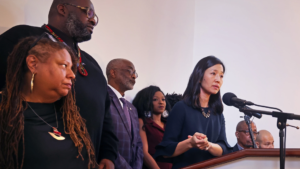NBC News and TargetSmart reviewed data about more than 60,000 spoiled ballots in 11 states, including Florida and Georgia.
Mail ballots returned by voters of color in two swing states where the race between President Donald Trump and Joe Biden is tight are being flagged for errors and possible rejection at disproportionately high rates, according to an analysis by NBC News and TargetSmart.
NBC News and TargetSmart, a Democratic political data firm, reviewed data about more than 60,000 spoiled ballots in 11 states, including two — Florida and Georgia — that have released the numbers of ballots flagged for errors or rejection broken down by race. More than 7,900 ballots cast by Black, Hispanic and Asian voters in those two states have been marked for voter errors at higher rates than those of white voters. However, the data from the 11 states show a low rejection rate overall.
In Florida, election officials have flagged Black, Hispanic and Asian voters at twice the rate of white voters. Election officials are working to contact individual voters with problem ballots, and they have until Thursday to rectify — or “cure” — their ballots for them to count. The most common reason a ballot is marked for rejection in Florida is that a voter didn’t sign the envelope, according to the early data.
In Georgia, where election officials in some counties said they haven’t finished counting all the ballots they’ve received, early number show stark racial disparities. Officials have flagged Asian voters’ mail ballots at nearly three times the rate of white voters’ mail ballots and Black voters’ mail ballots at over twice the rate of white voters’. Hispanic voters’ ballots were flagged at twice the rate of white voters’ ballots.
Georgia considers those ballots rejected, but officials will notify voters, and the ballots won’t be officially tossed until after Election Day. Georgia voters can cure their ballots, but only a handful have done so, according to the secretary of state’s office.
The disparities appear in line with data about ballot rejections in years past, when mail voting was less widespread. NBC News reported on the racial disparities in mail voting earlier this year.
Daniel A. Smith, a political science professor at the University of Florida who has been studying the effects of mail election regulations on the 2020 election, said institutional factors disproportionately affect voters of color.
Studies also show that racial inequalities exist at every level of American elections: Voters of color wait longer in line to vote, they’re less likely to have their questions answered by election officials, and they sometimes have less efficient mail service. The vast majority of Black voters have historically voted in person, and inexperience voting by mail can leave voters more likely to make unconscious errors, too.
Broadly, the data reveal a low rejection rate. About 0.27 percent of mail ballots in the 11 states have been flagged for errors. Not all of the 60,000 ballots will be rejected, however: Many states give voters an opportunity to fix problem ballots, which are often due to small errors like missing signatures. When all the ballots are counted, the overall rejection rate is likely to rise, because late arrivals are the No. 1 reason mail ballots are rejected.
A plurality, 44 percent, of the spoiled ballots come from Democrats, who are voting by mail more than Republicans. While Trump has warned falsely and frequently that mail voting is riddled with fraud, rejected or spoiled ballots aren’t necessarily proof of anything nefarious. The vast majority of flagged or rejected ballots are voter stumbles, according to experts.
Colorado has the highest number of spoiled ballots of the 11 states reviewed by NBC News and TargetSmart, with 14,106 ballots marked as spoiled. More than 12,000 of those ballots were marked because of signature discrepancies.
“Vote-by-mail is a different system. It has a different set of rules. The lack of familiarity can lead to higher rejection rates,” Smith said. He said inexperience voting by mail makes voters more likely to have their ballots rejected, regardless of age or race.
Younger voters also had higher rejection rates in eight of the 11 states that reported age data, another trend that has been noted in previous elections.
Nearly 2 percent of Colorado voters under 30 had spoiled ballots. In Florida, voters under 30 were four times as likely to have their ballots flagged as voters over 65. Experts say first-time voters are more likely to make mistakes when voting by mail.
Democrats, who have championed mail voting, are trying to reduce the number of ballots that are eventually rejected, Democratic National Committee Chairman Tom Perez said.
“If you look in Pennsylvania, we’ve spent millions of dollars in voter education, which is not something we always do at this point in the campaign — usually it’s just get out the vote,” he said last month. “We’ve done digital ads on here’s how you vote absentee, you put your [ballot] back in the security envelope.”
Perez said Democratic volunteers are reaching out to voters with spoiled ballots in North Carolina.
“Every Tuesday, every county releases names of people who have a defective ballot, and because we have a pretty robust voter file, we have the capacity to contact these people,” he said.




